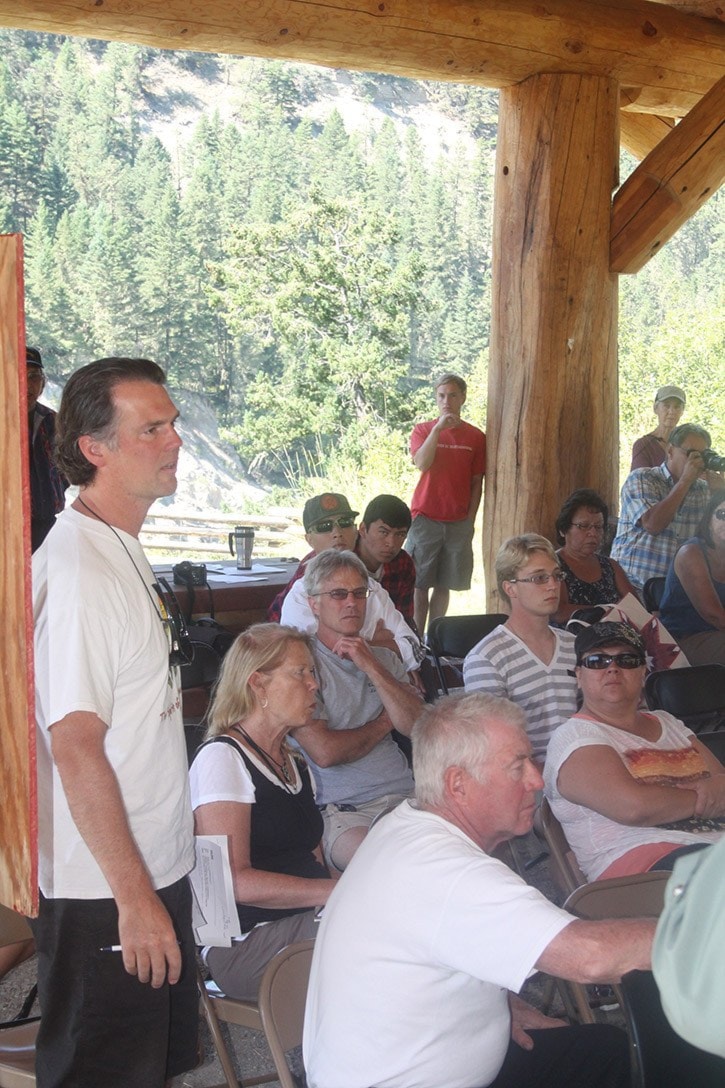Local and provincial First Nations dignitaries spoke to a crowd of about 80 people on Sunday at the Xat’sull (Soda Creek) cultural event to discuss issues surrounding the Mount Polley tailings pond breach — an event which has led to the Secwepemc’s (Shuswap) refusal to catch any salmon out of fear of contamination.
Grand Chief Ed John and his wife Wendy Grant-John, former Musqueam First Nation Chief, made the trip to Xat’sull to speak at the gathering.
Wendy was instrumental in arranging for her band to provide the Secwepemc (Shuswap) people with salmon caught 500-kilometres downstream near the Fraser delta. Wendy was contacted by Esk’etemc Chief Charlene Belleau asking if there was any way she could help.
“After I spoke to Charlene I called my brother Wayne (Musqueam Chief Wayne Sparrow) and he said ‘looks like we’re going fishing,’” said Wendy.
Sparrow rounded up his top fisherman and every one of them agreed to help.
The first salmon were expected to arrive in Williams Lake early this week.
“When people are in need the First Nations response is: how can we help? We simply respond to the needs of the Elders and Secwepemc Chiefs rather than apologize for the irresponsible actions of industry,” said Sparrow.
In what First Nations are calling heartless and illogical — the Department of Fisheries and Oceans is refusing to allow the Secwepemc (Shuswap) First Nations to apply some of their Section 35 (annual quota) salmon to be caught in the Musqueam First Nation’s downstream waters.
“I think that for the DFO to take the fish the Musqueam people catch for us and add that to their quota and not give them a special permit is absolutely wrong,” said Williams Lake Indian Band Chief Ann Louie.
DFO is insisting any salmon caught in Musqueam waters before they head further up the water system must be counted against Musqueam’s quota.
Despite the government’s position, the Musqueam people are committed to supplying these communities with healthy fish.
Xat’sull Chief Bev Sellars distrusts government’s claims that the water, which has had 15 million litres of mine slurry flooding into it, is fine for salmon fishing.
“We don’t believe the B.C. government’s water tests and have reviewed the list of toxic heavy metals that were released from the tailings dam earlier this week,” said Sellars. “They are doing their best to stand up for the mining industry and leave us in the background to suffer the consequences.”
John, who grew up in the Carrier village of Tache, 60 kilometres from Fort St. James, discussed how his Carrier people know the devastating effects of mining from their own painful experience. In 2004, a tailings dam failed and spilled into Pinchi Lake.
“For over 20 years Teck Cominco mine dumped mercury into Pinchi Lake, contaminating the fish — our traditional food source — from the lake,” said John.
He added that local Carrier bands were left in the dark as neither the government or company gave them any warnings of the danger.
John went from attending Lejac Residential School to becoming the North American Representative to the United Nations Permanent Forum on Indigenous Issues.
He worries the current situation at Mount Polley will suffer the same fate as Pinchi Lake.
“People have a right to be skeptical of industry and government – watch them try and whitewash this disaster,” said John.
John had hopes to visit the Likely area and see the damage for himself.
